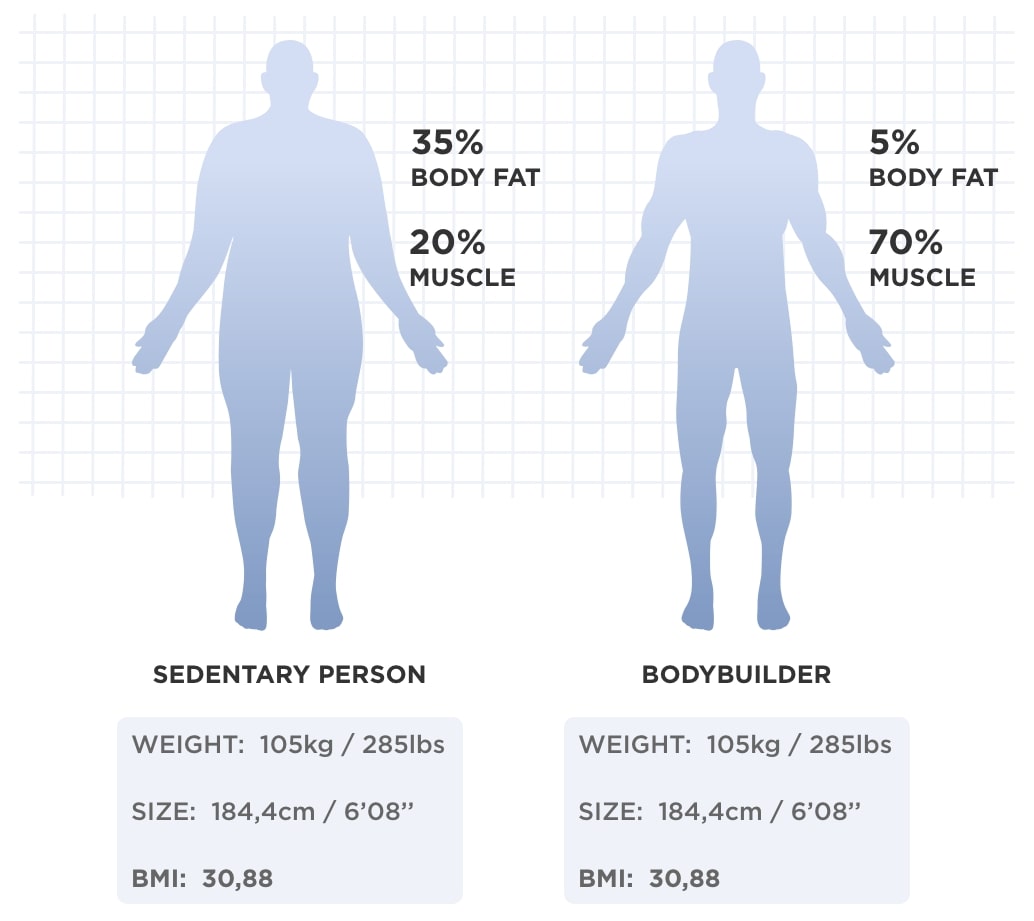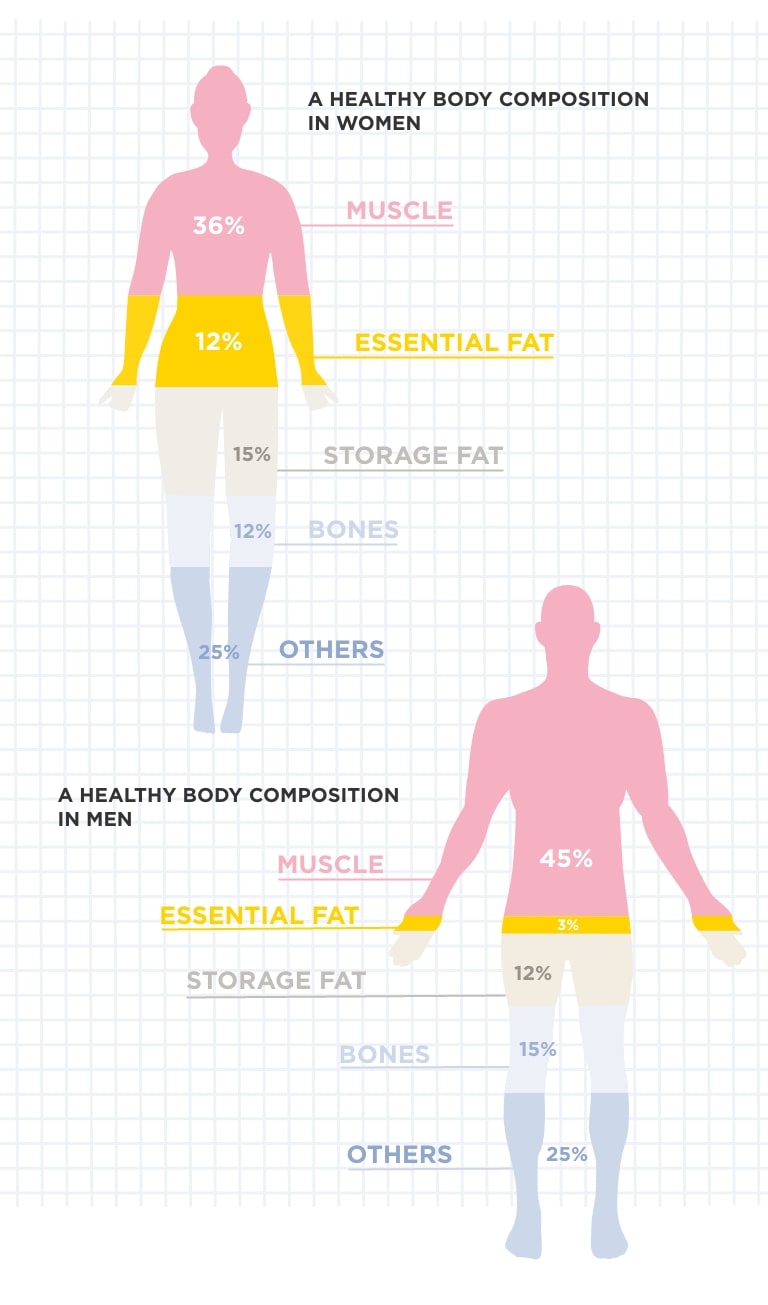
Exercise Watches for Women
Discover exercise watches for women by Withings. Track your workouts, heart rate, and more with accuracy. Designed for women who value...
Before you continue
Website version do not match with your country.
Pricing and product availability may vary by region.


Body composition includes all the elements that make up your body. It includes fat mass, muscle mass, bones, water and, depending on the definition, may also include some other fluids, gases and acids. Understanding how those core elements are distributed in your body can help you better understand your overall health.

💡 In short:
Body composition can give you a more accurate overall picture of your health, compared to other calculations such as BMI or body fat percentage, which don’t account for factors such as lean muscle mass. Your muscle, fat, and bone mass may change day to day for various reasons.
For example, if you’re on a weight loss journey, all that exercise may lead to an increase in lean muscle mass—which means your weight on the scale may not drop, or it may even increase, even though you’re making a positive change for your health.
Learn about your body composition and its calculation, how it impacts your overall health, and the potential risks associated with an unhealthy body composition.
The term “body composition” usually describes the percentage of fat, bone and muscle mass in your body.
Mainly used in physical fitness, since weight alone may not be a good indicator of how health you are, the term “body composition” was borrowed from the chemical interpretation of body composition, which focuses on the molecular distribution of the human body to differentiate the amount of proteins, lipids, carbohydrates, and other elements.
“From conception to old age, body composition is constantly changing, and it is changing at atomic, molecular, cellular, tissue and whole body level.”
Source: Food and Ageing Population, a renowned work on the science of the human body.
In adults and children, body composition has been acknowledged as a suitable metric to assess many health outcomes.
Unlike body mass index (BMI), which calculates your weight range (as underweight, normal weight, overweight, or obese) based on only your weight and height, body composition takes into account the various components your body is made of.

Muscle is more dense than fat. When we compare two people who are classified as “obese” according to BMI standards, but who have the same size, weight and age, their body composition may still be drastically different.
Although it is impossible to provide raw measurements, body composition can be estimated via a number of different methods.
In a clinical setting, tests may include dual-energy X-ray absorptiometry (DEXA), in which x-ray beams of different intensities are passed through a person’s body, and magnetic resonance imaging (MRI), an imaging technique that estimates the volume of fat in your body.
One popular method frequently used at home is bioelectrical impedance analysis (BIA), in which low-voltage electric currents circulate through the body via electrodes. BIA scales are the most widely used means of assessing body composition via bioelectrical impedance analysis from home.
Because your body composition is constantly changing, it’s also important to use the same measurement method over time.
If DEXA scans have a higher level of accuracy, having your body composition regularly checked to track muscle gains or fat loss via other less expensive methods such as bioelectrical impedance is very useful.
Unlike weight, your body composition shouldn’t be interpreted as a standalone figure, because it must be considered in context with your gender, age and metabolism.
By definition, a healthy body composition includes a low proportion of body fat, as well as a higher proportion of fat-free mass.
Figure: a healthy body composition expressed as a ratio of male and female bodies

Although your body requires a certain amount of body fat to maintain organ functions, a lower body-fat percentage is usually a sign of good health.
That said, charts from the American Council on Exercise may help you to better understand what is a healthy body fat percentage.
To know how much muscle mass you should have, it is important to differentiate the 3 types of muscles in the human body: cardiac muscles, smooth muscles, and skeletal muscles. Our activities can only impact the development of skeletal muscle mass, and it’s not possible to control the development of the two other types of muscle.
A research paper on the importance of skeletal muscle strength for healthy aging indicates that muscle mass naturally declines with age, a phenomenon called sarcopenia.
“Coupled to the loss of force generating capacity, there is a clear reduction of total muscle mass, at a rate of ~4.7 % peak mass/decade in men and ~3.7 % peak mass/decade in women.”
Note: when measured via bioelectrical impedance, "muscle mass" usually includes skeletal muscle, smooth muscle and the water contained in these muscles. Normal ranges for total body water (TBW):
Ages 20-39: 75-89% for men and from 63 to 75.5% for women.
Ages 40-59: 73-86% for men and from 62 to 73.5% for women.
Ages 60-79: 70-84% for men and from 60 to 72.5% for women.
Carrying sufficient muscle mass is necessary for good health, as it helps you burn more calories, builds protection against certain chronic diseases such as diabetes, and improves your overall metabolic rate.
A number of factors can affect your body composition levels, keeping track of your body composition over time—including bone and muscle mass—can help you and your healthcare provider make the right decisions for your health. Among the main factors that influence body composition, we count:
Age
“In general, as individuals age, percent body fat increases and lean mass and bone mineral density decrease. Furthermore, the increase in fat mass (FM) is distributed more specifically in the abdominal region, an area associated with cardiovascular disease and diabetes.”
Gender
Females naturally have—and need—more body fat than males. In terms of body fat types, they usually carry less visceral fat, but more subcutaneous fat, which is stored around the hips and thighs. Changes in fat mass typically appear after puberty.
Genetic determinants
Many large-scale studies have identified different types of genetic factor that influence the body fat distribution. One recent study, entitiled “Genome-wide association study of body fat distribution identifies adiposity loci and sex-specific genetic effects", found “98 independent genetic signals to be associated with body fat distribution, as determined by BIA, of which 29 have not previously been associated with any adiposity-related phenotype.”
Food intake
Nutrition, especially the amount of calories you are eating, can significantly alter body composition over time (and if associated with physical activity). The importance of proteins is acknowledged for people who wish to gain muscle.
Thyroid hormones
According to study findings published in Clinical Endocrinology, “thyroid hormones play crucial roles in the control of energy homeostasis and thermogenesis and can therefore influence body composition.” People with thyroid dysfunction may have more difficulty in controlling their body weight.
Growth hormones
The growth hormone (or GH) is known for increasing energy expenditure. People with metabolic disturbances who suffer from GH deficiencies will have more difficulty in burning calories, which may result in more visceral adiposity.
Steroid hormones
In women, cortisol, as well as estrogen and progesterone, play an important role in fat distribution. Women with a good hormonal balance will find it easier to control their body composition. In men, studies have shown that lower levels of testosterone are associated with increased body fat.
Physical activity
Exercise is key to achieving a healthy body composition. When you exercise, your muscles will develop: they grow and get stronger. On the other hand, sedentary behavior will accelerate fat deposition and may cause obesity.
Sleep habits
Scoring enough sleep can increase your metabolic rate—which is key to burning calories. On the other hand, even if insufficient sleep or irregular sleep patterns plays a major role in the health status of individuals, it is still unclear how poor sleep negatively affects your body composition.
Alcohol consumption
Just like carbohydrates, alcohol suppresses fat oxidation. In other words, it reduces the ability of your body to burn fat for energy. However, it is acknowledged that only 3-5% of alcohol can be converted into body fat.

Exercise Watches for Women
Discover exercise watches for women by Withings. Track your workouts, heart rate, and more with accuracy. Designed for women who value...

Boost your physical activity
Find the best watch to track your physical activity.

Track body fat
Measure your body fat with a body composition scale.
People who appear thin are often assumed to be healthy. The trending term “skinny fat” actually describes a condition in which people think they are healthy since their BMI seems to be normal, but in reality, they tend to have not enough muscle mass and carry too much body fat. Carrying too much body fat can be dangerous to your health, because it increases insulin resistance (which might lead to type 2 diabetes) and the risk for cardiovascular diseases.
"Body fat percent may be a useful predictor of risk, particularly in metabolically obese, normal weight individuals".
Source: Correlation between body composition and risk factors for cardiovascular disease and metabolic syndrome.
Other changes in body composition may also impact your health—for example, if you notice a decrease in bone mass with age, you may want to check with your doctor. Therefore, it’s important to know your body composition, and to track changes and trends so you can share them with your healthcare provider.
The short answer: exercise! Physical activity can help you increase your amount of lean muscle mass, which has been shown to have a number of health benefits, including fighting obesity and protecting against diabetes and insulin resistance.
A 2017 review in Advances in Nutrition noted that endurance and resistance exercises helped to preserve muscle mass during weight loss, and resistance training helps to improve muscle strength.
Exercise can help you maintain a healthy bone mass level, too.
Our bones tend to deteriorate as we age, and there is also a reduction in bone formation. This can lead to osteoporosis, which can increase the risk of dangerous falls and fractures.
A report in Therapeutic Advances in Musculoskeletal Disease notes that physical exercise can help, citing studies that show that activity can improve bone mass, and even prevent bone loss in women.
You may also want to reduce excess (storage) fat, especially around the belly.
Experience unmatched accuracy with Withings Wi-Fi smart scales. Our precise and powerful health scans work in concert with advanced algorithms, refined through thousands of measurements, and deliver detailed body composition analysis and key health metrics. Track your progress confidently with data that syncs automatically to the Withings app via Bluetooth / Wi-Fi. Choose the scale that evolves with you, providing unparalleled insights for your health journey.
Join millions of users who are improving their health with Withings. Sign up to discover the entire Withings ecosystem, our latest products, and exclusive offers.
By registering, you agree to receive advertising e-mails from Withings. However, if you change your mind, you can unsubscribe at any time.